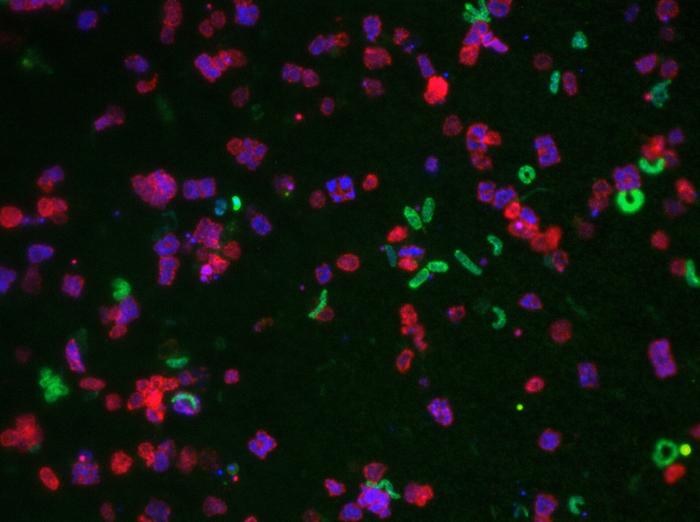
The longstanding belief that bacteria do not form distinct species has recently been challenged by groundbreaking research led by microbiologist Kostas Konstantinidis from the Georgia Institute of Technology. For years, scientists maintained that due to their unique methods of genetic exchange and the vast diversity within their populations, bacteria existed in a fluid state of genetic variation, making it nearly impossible for distinct species to emerge. Konstantinidis’s work suggests a paradigm shift: not only do bacteria indeed form species, but they maintain distinct identities through mechanisms akin to “sexual” reproduction.
The research team’s pioneering study has illuminated the underlying processes that allow bacteria to retain cohesiveness within their species. Konstantinidis articulated the complexity of this phenomenon, stating, “The next question for us was how individual microbes in the same species maintain their cohesiveness. In other words, how do bacteria stay similar?” This inquiry delves into the heart of microbial genetics and evolutionary biology, revealing how these organisms manage to remain genetically cohesive despite their seemingly chaotic lifestyles.
Microbial evolution has traditionally been understood through the lens of binary fission, a form of asexual reproduction. However, this research introduces a more nuanced understanding by demonstrating that, through a process called homologous recombination, bacteria can exchange genetic material, thereby contributing to the evolution and stability of their species. This novel approach to studying bacterial population genetics combines advanced bioinformatic techniques with an extensive database of genomic sequences, enabling a deeper analysis of microbial species dynamics.
In this study, Konstantinidis and his international team examined the complete genomes of microbes from two distinct natural populations. Over 100 strains of Salinibacter ruber were collected and sequenced from solar salterns in Spain, representing a salt-loving microbial community. Additionally, they analyzed previously published genomes of Escherichia coli sourced from livestock farms in the U.K. This comprehensive approach provided critical insights into how genetic exchanges occur within closely related microorganisms.
The researchers scrutinized the prevalence of homologous recombination and discovered that it plays a fundamentally significant role in maintaining the coherence of microbial species. This recombination occurs not just in designated areas of the genome, as was previously thought, but throughout the entire DNA structure of microbes, suggesting a pervasive and robust mechanism for genetic exchange. Konstantinidis posited, “This constant exchange of genetic material acts as a cohesive force, keeping members of the same species similar.” This finding closely parallels the sexual reproduction mechanisms observed in non-bacterial organisms, shedding light on a previously underappreciated aspect of microbial evolution.
By demonstrating that members of the same species exhibit a higher propensity for DNA exchange with one another than with members of different species, this research elucidates how distinct species boundaries are formed and maintained. This insight is essential for microbiological taxonomy and has been a longstanding conundrum within the field. As Konstantinidis remarked, “This work addresses a major, long-lasting problem for microbiology that is relevant for many research areas.”
The implications of this research extend far beyond theoretical biology. Understanding the mechanisms by which microbial species form and maintain cohesiveness is crucial in various fields such as environmental science, medicine, and public health. For example, it can inform strategies for managing microbial populations, enhancing bioremediation efforts, and even tackling antibiotic resistance, which poses a substantial threat to global health.
In an age where microbial communities are increasingly recognized for their role in ecosystem functioning and human health, this investigation not only fills a gap in our understanding but also offers a novel molecular toolkit for future research. With methodologies developed during this study, scientists can delve deeper into epidemiological investigations and the intricacies of microbial diversity.
This research was supported by a collaborative effort that included contributions from esteemed groups such as Ramon Rossello-Mora at IMEDEA in Majorca, Spain, and Rudolf Amann at the Max Planck Institute for Marine Microbiology in Bremen, Germany. Their collective expertise enabled the collection, sequencing, and subsequent analysis of natural microbial populations, emphasizing the research’s interdisciplinary nature.
The publication of this study in Nature Communications represents a significant milestone in microbiology, further validating the concept of bacterial species while simultaneously challenging the assumptions that have shaped our understanding of microbial life for decades. Its transformative conclusions invite reassessment of current microbiological paradigms and promote further investigation into microbial genetics.
In conclusion, Konstantinidis and his team have effectively dismantled the historical view of bacteria as amorphous entities devoid of species allegiance. By introducing homologous recombination as a driving force behind species fidelity amongst bacteria, their work reveals an intricate reality wherein microbial life engages in complex genetic behaviors. This expands the horizon for future research and reinforces the importance of understanding microbial species dynamics in both ecological and clinical contexts.
Subject of Research: Mechanisms maintaining microbial species cohesiveness through genetic exchange
Article Title: Microbial species and intraspecies units exist and are maintained by ecological cohesiveness coupled to high homologous recombination
News Publication Date: 15-Nov-2024
Web References: 10.1038/s41467-024-53787-0
References: Conrad, R.E., Brink, C.E., Viver, T. et al. Nature Communications. DOI: 10.1038/s41467-024-53787-0
Image Credits: Credit: Tomeu Viver
Keywords: Microorganisms, Environmental methods, Bacterial DNA, Genomic DNA, Homologous recombination, Population genetic models, Evolutionary developmental biology, Microbial evolution
Tags: asexual vs sexual reproduction in microorganismsbacterial species formationcohesiveness in microbial populationsdistinct identities of bacterial speciesevolution of bacteriagenetic exchange mechanisms in microbesgroundbreaking studies in microbiologyhomologous recombination in bacteriaKostas Konstantinidis researchmicrobial genetics and evolutionparadigm shift in microbiologysexual reproduction in bacteria





